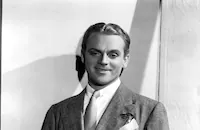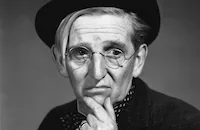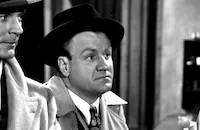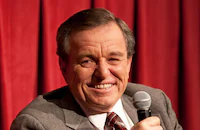The Seven Little Foys

Brief Synopsis
Cast & Crew
Melville Shavelson
Bob Hope
Milly Vitale
George Tobias
Angela Clarke
Herbert Heyes
Film Details
Technical Specs

Synopsis
On Christmas Day, in 1913, entertainer Eddie Foy and his seven children¿Bryan, Charley, Richard, Mary, Madeleine, Eddie, Jr. and Irving¿perform for the first time at New York's celebrated Palace Theatre. As they sing and dance, Charley, Eddie's second child, recounts how the family got its start: One night, in 1898, while performing as a solo act in a revue, Eddie learns that influential talent agent Barney Green has come to check out his act as a possible addition to the Palace's line-up. Anxious, Eddie, who views women as impediments to show business success, refuses to switch dressing rooms with newly arrived Italian classical dancer Madeleine Morando and her accompanist, sister Clara, despite Madeleine's flirtations. When the Morandos take repeated encores, threatening to drive the bored Barney out of the theater, Eddie joins them on stage, turning their serious presentation into a comedy. Barney laughs hysterically at Eddie's impromptu lampoon and, after the show, offers him a four-week contract. Eddie is overjoyed until Barney reveals that the offer is valid only if the Morandos become part of his act. Desperate to play the Palace, Eddie invites Madeleine to dinner and plies her with champagne. Before he can broach the subject of the contract, however, Barney shows up and, assuming that Madeleine already knows about it, mentions the deal. Infuriated, Madeleine storms out of the restaurant, followed by Eddie. Although Eddie apologizes and admits his attraction to Madeleine, kissing her, the two part ways. While Eddie tours the West, Madeleine returns to Italy with Clara. Sometime later, in San Francisco, Eddie receives a letter from Madeleine, informing him of her impending marriage to an Italian admirer. Eddie races to the La Scala in Milan, where Madeleine is rehearsing, and after much hesitation, proposes. Madeleine happily accepts and agrees to join Eddie's act with Clara, but when they arrive in New York after the honeymoon, Clara tells Eddie that his wife is pregnant and cannot perform. Despite the setback to his career, Eddie takes the news in stride, and seven months later, Bryan, nicknamed "Brynie," is born. Eddie continues his touring vaudeville act, but after Madeleine reveals that she is expecting another child, decides to "settle down" by joining the cast of a play. Later, Eddie and five-old-year Brynie are backstage at the Iroqouis Theatre in Chicago, where Eddie is starring in Mr. Blue Beard , when a fire breaks out. After making sure Brynie is safe, Eddie goes on stage to calm the panicked audience and is hailed as a hero for his efforts. Eddie then is cast in a series of Broadway shows, and Madeleine gives birth to five more children. Fulfilling Madeleine's dream of living in the country, Eddie buys the family a large but rundown house in rural New Rochelle, New York, and presents his wife with an engagement ring. Madeleine is moved by the gesture and does not complain when Eddie hurries back to the city to perform in a George M. Cohan tribute. Clara and the children, however, criticize Eddie for neglecting his parental duties and indulging in his personal ambitions. Later, after Eddie resumes touring, Madeleine falls gravely ill but chooses not to tell Eddie about her condition. Upon returning to New York, Eddie learns that Cohan is honoring him with a Friars Club "Father of the Year" award and goes to the dinner instead of home. After dancing on the table tops with Cohan, Eddie heads for New Rochelle and is devastated when a priest informs him that Madeleine died earlier that day. Six months later, Barney visits Eddie in New Rochelle and chastises him for spoiling his now wild children and abandoning the stage. Determined to revive Eddie's career, Barney announces he has booked an engagement and suggests Eddie add his children to his act. Eddie is skeptical, especially after watching his untrained children try to sing and dance, but spends the next several weeks coaching them. Eddie Foy and the Seven Little Foys are an instant success, and Eddie arranges a tutor for them while they tour the country. Clara, however, disapproves of the vagabond life style and begs Eddie to take the children home for Christmas. Eddie agrees but Barney later announces that he has booked the family at the Palace, beginning Christmas Day. Eddie refuses to give up the long-coveted engagement, and despite Clara's and the children's resentment, the Foys perform on Christmas Day. Unknown to Eddie, Clara has brought agents from the Society for the Prevention of Cruelty to Children to the show, and afterward, Eddie is hauled into New York's Children's Court. Confronted with a local law that prohibits children from entertaining for money, Eddie pleads guilty, but states that he was merely teaching his children the only profession he knows. The children jump up to defend Eddie, declaring that they love show business and their father, and while touched by their sentiment, the judge maintains that Eddie nevertheless violated the law. To prove the judge wrong, the children sing and dance terribly, and after conceding that their performance cannot be deemed entertainment, the judge drops the charges. Later, in New Rochelle, Eddie shocks the town when he joins Clara and his children at Sunday Mass for the very first time.

Director

Melville Shavelson
Cast

Bob Hope
Milly Vitale

George Tobias

Angela Clarke
Herbert Heyes
Richard Shannon

Billy Gray
Lee Erickson
Paul De Rolf
Lydia Reed
Linda Bennett
Jimmy Baird
Tommy Duran

James Cagney
Charley Foy
Lester Mathews
Joe Evans
George Boyce
Oliver Blake
Milton Frome

King Donovan

Jimmy Conlin
Marian Carr
Harry Cheshire
Renata Vanni
Noel Drayton
Joe Flynn
Jack Pepper
Dabbs Greer
Billy Nelson
Hy Anzel
George Pembroke

Lyle Latell
Gilbert F. Fallman
Duke Johnson
Joe Bassett
Richard Keene
Angi O. Poulos

Jerry Mathers
Max Power
Edward C. Short
Fred Zendar
Jerry Chiat
E. William Seckler
Lewis Martin
Morgan Brown
Len Hendry
Crew
Charles Berner
Richard Blaydon
Monroe W. Burbank
Nick Castle
George M. Cohan
Sam Comer
John Cope
Farciot Edouart
Charley Foy
Eddie Foy
John P. Fulton
John Goodman
Edith Head
Len Hendry
Ellsworth Hoagland
William Jerome
Hal C. Kern
Gene Liggett
Joseph J. Lilley
Joseph J. Lilley
Harry Lindgren
Nick Marcellino
Frank Mckelvy
James V. Monaco
Michael D. Moore
Charles Norton
Hal Pereira
Bill Rand
Alex Rogers
Jack Rose
Jack Rose
James Rosenberger
Jean Schwartz
Melville Shavelson
Betty Uitti
John F. Warren
Wally Westmore
Bert Williams

Videos
Movie Clip



Film Details
Technical Specs

Award Nominations
Best Writing, Screenplay
Articles
The Seven Little Foys
The sequence depicting Hope being informed of his wife's death is especially dramatic. Foy is shown drinking and carousing mere blocks from the hospital in which his wife (Italian actress Milly Vitale in one of her few American films) is dying, only to be told of her death the next day. The night before Hope shot this scene, a real-life close friend died of cancer. Hope undoubtedly used his personal devastation in shooting the scene, and the result is one of the most serious and dramatic on-screen moments in Hope's career.
The highlight of the picture, however, is a seven-minute sequence in which James Cagney reprises his Oscar®-winning role of George M. Cohan (from Yankee Doodle Dandy [1942]) and dances on a tabletop with Hope after the duo trade comic barbs. Cagney was more than happy to supply this cameo. For one thing, he was eager to lose fifteen pounds, "so [Hope] and I rehearsed the dance for three weeks, and I lost my unwanted lard." (Cagney by Cagney) For another, Cagney saw this as an opportunity to pay tribute to the memory of Eddie Foy, who had helped him when he was just starting out: "When I was a starving actor," Cagney wrote, "I could always get a free meal and a friendly welcome at the Foys. You don't forget things like that." Therefore Cagney refused a salary for his work on The Seven Little Foys.
He did have a little trouble with the dance number, however. In his three weeks of rehearsal he incorporated a step that placed extra strain on his knees, and when the cameras were rolling and he jumped up onto the table, his knees shot through with severe pain. But Cagney was a professional hoofer and soldiered on. "I didn't change expression but reached down and pulled Bob up. We proceeded to do the routine with both my legs paining almost beyond endurance.... Right after the number I called Bob into my dressing room and showed him my knees. He couldn't believe it. They were full of fluid, easily twice their normal size. But in a few days they were normal again and I was all right. I guess at fifty-six even a longtime song-and-dance man can't expect to bounce around in quite the same way he did at, say, fifty."
The Seven Little Foys was the first producing-directing effort for writers Melville Shavelson (who directed) and Jack Rose (who produced). The pair were longtime writing partners and gag men who had a long association with Hope. In his memoir (How to Succeed in Hollywood Without Really Trying, P.S. -- You Can't!), Shavelson wrote that when he and Rose approached Hope about this film, Shavelson told the star: "Bob, there's a catch. You can't have the story unless I direct it and Jack produces it, and neither of us have ever directed or produced anything in our lives." Hope thought it over for a moment, then replied, "My last picture was so lousy, you guys can't possibly do one lousier."
According to Shavelson, he, Rose and Hope all worked for deferred salaries, to be paid from the film's profits. "The Seven Little Foys was so successful," he wrote, "Paramount was too surprised to lie. To buy out our rights so they would keep all the picture's future earnings, Jack and I were offered a contract to write, produce and direct a series of films for the studio. Part of the deal included a hefty chunk of Paramount Pictures stock. I later sold my stock, much too soon, it turned out, but I didn't mind. For a short time, I had been a minor mogul."
In his many stints as Oscar® host, Bob Hope often joked about his own lack of an acting Oscar®. The Seven Little Foys was one of four films in his career that he really hoped would finally land him a nomination, but it was not to be. (The others: Monsieur Beaucaire [1946], Beau James [1957], The Facts of Life [1960].) This film did garner one nomination, however, for Best Story and Screenplay, but it lost to Interrupted Melody (1955).
Two of the real-life Seven Little Foys took part in the making of this film: Eddie Foy, Jr. supplies the voice-over narration, and Charley Foy serves as technical adviser. Look for Jerry Mathers (child star of TV's Leave It to Beaver) playing Bryan Foy at age 5.
Producer: Jack Rose
Director: Melville Shavelson
Screenplay: Melville Shavelson, Jack Rose
Cinematography: John F. Warren
Art Direction: John Goodman, Hal Pereira
Music: Joseph J. Lilley
Film Editing: Ellsworth Hoagland
Cast: Bob Hope (Eddie Foy), Milly Vitale (Madeleine Morando Foy), George Tobias (Barney Green), Angela Clarke (Clara Morando), Herbert Heyes (Judge), Richard Shannon (Stage Manager), Billy Gray (Bryan Lincoln Foy, as a teen), Lee Erickson (Charley Foy), Paul De Rolf (Richard Foy), Lydia Reed (Mary Foy).
C-93m.
by Jeremy Arnold

The Seven Little Foys
Quotes
Trivia
James Cagney won an Oscar for playing Broadway producer George M. Cohan in Yankee Doodle Dandy (1942). He agreed to play Cohan again in "The Seven Little Foys" on condition that he would not be paid for the role. He did the role as a tribute to Eddie Foy, who had generously provided occasional meals for struggling young actors, including Cagney, in 1920's New York.
Notes
The working titles of this film were The Eddie Foy Story and Eddie Foy and the Seven Little Foys. Most of the opening credits are preceded by the scene depicting the Foys's Christmas Day debut at the Palace Theatre. The title cards read: "Bob Hope as Eddie Foy in The Seven Little Foys." Music credits include the notation: "Featuring the songs sung by Eddie Foy."
Eddie Foy, born Edwin Fitzgerald in 1856, began his show business career as a child, singing and dancing in the streets of New York and Chicago in support of his family. In the late 1870s, he began touring western mining camps and cow towns, including Tombstone, where he performed for legendary lawmen Bat Masterson and Wyatt Earp. He returned to Chicago in 1888 as a comic headliner in revues and variety shows. As depicted in the film, on December 30, 1903, while appearing in the musical Mr. Blue Beard at Chicago's Iroquois Theatre, Foy helped battle a fire that claimed 600 lives, urging the panicked audience to remain calm. Foy first appeared on the vaudeville stage with his seven children in August 1912; in 1913, the family undertook their first regular tour. Unlike in the film, the family act was not created as a result of the death of Foy's wife, Madeleine Morando Foy. Madeleine, who was actually Foy's third wife, travelled with the act, along with a nurse and a governess, until her death in 1918. The Foy Family, who were based in New Rochelle, NY, toured the vaudeville circuit for ten years, enjoying great popularity during World War I. Foy died in 1928.
Foy appeared in two films-by himself in Vitagraph's 1910 film Actors' Fund Field Day (see AFI Catalog. Film Beginnings, 1893-1910) and with his children in a 1915 Mack Sennett short, A Favorite Fool. Foy's oldest son, Bryan "Brynie" Foy (1896-1977), became a successful film director and producer. Eddie, Jr. (1905-1983) continued in show business as a stage and film actor. Foy, Sr.'s youngest child, and his last surviving offspring, was Irving, who died in 2003. Foy's grandson, Eddie Foy III, made his screen acting debut in 1955 and later became a casting director. Eddie, Jr. played his father in the 1939 Twentieth Century-Fox release Frontier Marshal, reenacting Foy's reputed encounter with Wyatt Earp (see AFI Catalog of Feature Films, 1931-40), and in the 1943 Warner Bros. film Yankee Doodle Dandy, a biography of George M. Cohan, which starred James Cagney as the famed entertainer and songwriter (see AFI Catalog of Feature Films, 1941-50). Cagney recreated the Cohan role in The Seven Little Foys.
The Seven Little Foys marked the first time that Hope had starred in a film biography, and the first time he impersonated a "song-and-dance man." It also marked the producing debut of Jack Rose and the directing debut of Melville Shavelson. Rose and Shavelson had been Hope's radio gagmen, as well as successful screenwriters, and according to modern sources, approached Hope with the idea of starring in a Foy biography. Hope Enterprises, which co-produced with Paramount and Rose and Shavelson's company Scribe Productions, negotiated for a forty-four percent cut of the film's profits, according to modern sources. In addition to Charley Foy, who narrates the picture, Hope consulted with Bryan and Eddie, Jr. prior to making The Seven Little Foys. Contemporary sources note that Eddie, Jr., who was starring in the Broadway production of The Pajama Game at the time of production, was originally to do the narration. Several reviews incorrectly credit him as narrator.
Modern sources state that Cagney took the part of Cohan as a favor to Hope (and to lose weight) and performed without contract, or compensation. One modern source claims that Cagney refused pay because the Foy family had befriended him when he was a struggling actor and Cagney wanted to return the kindness. Hope rehearsed extensively with Cagney on their dance routine. Hollywood Reporter news items and production charts add the following actors to the cast: Don Harvey, Fred Sweeney, Philo McCullough, Paul MacWilliams, Rex Moore, Nick Borgani, Harlan Hoagland, John Marlin, Thomas F. Martin, Frank Meservy, Frank Baker, James Gray, Kenneth Gibson, Raoul Freeman, Wallace Dean, Jack Deery, Dan Dowling and David Kasday. The appearance of the these actors in the final film has not been confirmed. Location shooting took place in Sierra Madre, CA, according to an August 1954 Hollywood Reporter news item.
The film's June 1, 1955 world premiere in Sydney, Australia, and its premiere in Los Angeles were benefits for the Cerebral Palsy Fund, according to Hollywood Reporter news items. The Seven Little Foys was nominated for a Best Writing (Story and Screenplay) Academy Award. In late January 1964, the NBC television network broadcast The Seven Little Foys, a second version of the story, starring Eddie Foy, Jr. as his father, Mickey Rooney as Cohan and four Osmond Brothers as Foy children. George Tobias recreated his role as "Barney Green" for the television broadcast.

Miscellaneous Notes
Released in United States Summer July 1955
Directorial debut for Melville Shavelson.
VistaVision
Released in United States Summer July 1955













